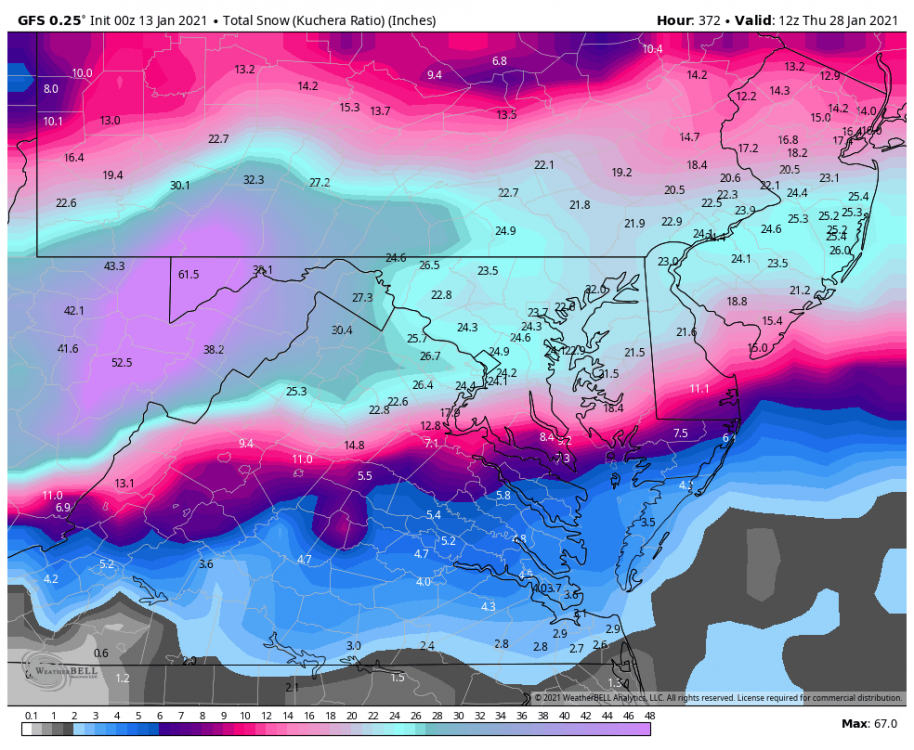-
Posts
26,583 -
Joined
-
Last visited
Content Type
Profiles
Blogs
Forums
American Weather
Media Demo
Store
Gallery
Everything posted by psuhoffman
-
I am not saying the wave around the 22-23 couldn’t work. It’s has a decent shot. Just saying imo the progression gets even more favorable just after that.
-
I’ve been wrong plenty of times too though. Lol that one in 2016 was easy to see the setup from REALLY far out. Even though it didn’t really show on ops until about 9 days out the setup was crystal clear well before that from the way the pattern was progressing although I think I might have originally targeted a day or two too soon as the wave slowed a lot. I also “saw” that 2011 and the Feb 2010 storms from really far out but those were slightly less difficult patterns. The blocking was similar but we didn’t have the raging pac jet we do now. That complicates things. I would not put this threat (late Jan) quite at the same level of confidence as those long range calls. But it’s very good. If those were level 10 (for long range) this is an 8 level. There is more that could go wrong here with the current pac but it’s still a very good chance. I am intrigued by the progression. We’re kind of stuck in a squeeze play. The EPO ridge will put more cold into the US. It will be centered out west initially but it will bleed east under the block more behind each wave. At the same time as the NAO Rex block retrogrades SW from Greenland into Northern Quebec the blocked flow will intensify. That will trap more cold in from the northeast (that over time bleeds into the pattern). At the same time the weakness between the western trough and the eastern trough will allow gulf systems to organize and try to cut. But that will become increasingly difficult as the block retrogrades. I’m simply playing that progression out and “guessing” about the 26-28th is the magic spot where there is enough cold into the pattern and the block has retrograded enough to get something trying to cut to get forced to secondary under us. Hybrid miller b. Those can be NICE. Hopefully my imagination is close to reality.
-
The period around the 26th seems the most favorable of all the hypothetical waves were watching.
-
I don’t hate this gfs run. Absolutely beautiful look to the significant longwave features. Perfect NAO block and the epo ridge breaks so much so it cuts off into a Rex block north of AK which allows a vortex to cut south of Ak and pumps a PNA. I would rather see good things from large scale features driving the pattern the model is more likely to get right then details of discreet SWs flying around in the flow. Give me that progression and I’ll take my chances something works out.
-
It starts in the TX panhandle and gets to Columbus before being stopped by the blocking. We can call it whatever, it’s not a pure cutter though. But it’s no good lol. But it took a lot going wrong to get that...it wouldn’t take much to see a better solution.
-
I was wrong the euro digs it south not north. I was looking at different SWs. At 120 the gfs/euro are similar. Then they diverge...both have a SW coming into AK. The GFS amplifies it and it moves south east ending up north of the lakes wrecking the flow. Plus the southern end of the trough cuts off and gets stuck in the southwest. The euro dives that AK low south and phases with the southern SW and they come east with a high over the top where the low is on the gfs. Pretty major progression differences for only 120 out.
-
One major difference is how they handle the flow in Canada. The euro has a SW way up north out of the way while the GFS digs that further south just north of the lakes which impacts the flow over the US. Where the euro has a high over the top the gfs has a low creating a weakness for the storm to cut because of how they handle that feature.
-
Still no sign of blocking breaking down. But it has to actually help at some point lol. My guess if it holds i through early Feb it will. Kinda hard to run a block through Jan 20-Feb 10 and not snow. That would be something
-
I see the potential. I’ve been leading the charge on the potential. But the way you worded it confused me. “That would be a memorable run” threw me. Not if it went down exactly as shown lol.
-
So long as that blocking is there we will have a shot at every wave. But there is a real problem on the pac side. The ridge is retrograding too fast and really pulling the us trough too far west.
-
I’m pointing out what it shows.
-
We’re also getting a lot of bad luck here. We’ve been cold enough, not cold but cold enough, to snow recently but the last several waves got shredded. We need less split of the trough in this upcoming pattern. I still doubt these cutter looks with that block.
-
What para are you looking at?
-
Gefs is beyond frustrating through day 13. The means look good wrt precip/temps but nada on the snow maps. Looking into individual members reveals why. The temps are skewed colder by cold dry members. The wet members are warm. It’s either suppressed members or cutters. Lol
-
12z Gfs had the epo ridge and did the same
-
What pattern isn’t frustrating lol
-
Instead of a broad spread out w-e trough under the epo/NAO ridge (which is typically what you would expect) the guidance tries to split the trough and pump a ridge in between. Ugh
-
That suppressed storm is north on the ensemble and Gfs so I don’t mind seeing the euro south. Still think we see even better opportunities as the block retrogrades but that isn’t a bad window. So we should close this thread then since this is for pattern and threats 7+ days out? We have a different thread for day 3-6 stuff now.
-
-
And remember...the op Gfs did EVERYTHING wrong days 1-10 then still managed to get a flush hit because of that block. Even if other factors aren’t great that block given enough chances might come through. But yea I’d like the Pac to cooperate more and not make this so god darn difficult.
-
They come out 1-3am. For now enjoy the Jan 27 HECS on the GFS
-
No one should be giving up on anything past day 6 with that kind of blocking.
-
GFS op is doing what the 18z op did...not a poleward enough EPO ridge...so it dumps all the trough into the west and pumps an eastern ridge... the block can only so do much about that.
-
It's not REALLY a cutter...it tracks right over us and transfers...miller b hybrid that doesn't jump in time. And I would wait another couple days before being sure that solution is likely...were still at the range where things could change significantly and given that blocking...it wouldn't shock me if the changes is south. That said...we continue to not see the cold press the way we really need...and that is something that can't be ignored since its been a common theme for a LONG time.
-
isnt that the storm the euro had as a deep south snowstorm lol







